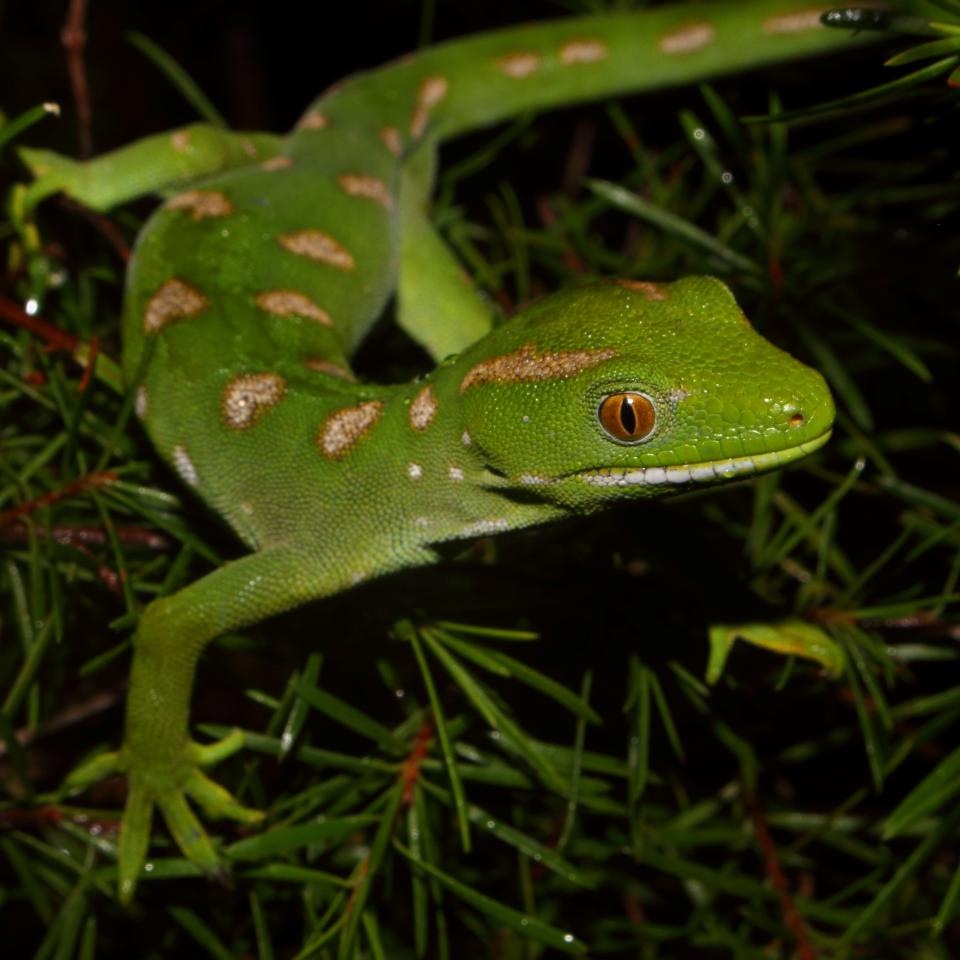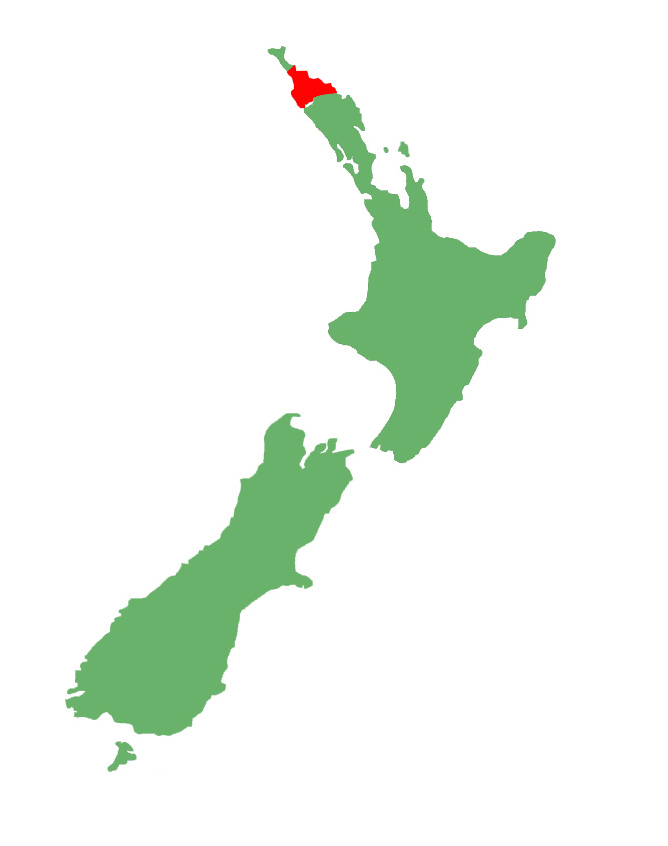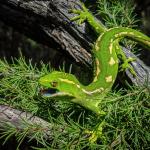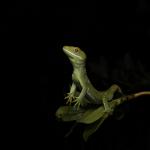- Home
- Herpetofauna Index
- Native
- Naultinus Grayii
Naultinus grayii
Northland green gecko | Kawariki
Naultinus grayii
(Bell, 1843)
Length: SVL up to 100mm, with the tail being longer than the body length
Weight: up to 23 grams
Description
A large and often beautifully patterned green gecko from the far north of New Zealand. Northland green geckos - along with the barking gecko (Naultinus punctatus) - are regarded as the largest species amongst Aotearoa's green geckos (Naultinus).
These geckos are characterised by their bright to pale green upper surfaces, which in some individuals are broken up by white or yellowish markings (either striped, blotched, or a combination of both). These markings are often highlighted by brilliant golden edging (particularly in northern populations), although grey or black edging is not atypical either. The sides of the animals are much the same as the upper surfaces, although may be underlined by a thin white stripe, and in some males may be flushed with a pale blue colouration. Their mouth is often bordered below by a white stripe which terminates at the opening of the ear. The ventral colour is pale green, sometimes with a yellow tinge, although some males exhibit a blue-tinged stomach.
Mouth and tongue colour is a key feature in distinguishing between North Island Naultinus species, and the Northland green gecko fits this pattern, having the unique combination of a deep blue mouth with a red tongue.
Xanthochromic (yellow) individuals have been reported.
Can be differentiated from elegant geckos (Naultinus elegans) by a red (versus blue) tongue, and from Aupōuri geckos (Naultinus flavirictus) by a blue (versus lilac/pink) mouth colour. Northland green geckos can be distinguished from both species by having flat (versus domed) canthal scales. There is some evidence of past hybridisation with the elegant gecko (N. elegans) at the southern extent of their range, with animals occasionally having a mix of those traits (N & T. Harker pers. comm March 2022).
Life expectancy
Northland green geckos have been recorded reaching ages of ~25 years in captivity, but are likely to exceed this.
Captive green geckos have frequently been known to live for upwards of 25 years, with some individuals topping the records at 50+ (D. Keal pers. comm 2016). In the wild, green geckos have been recorded as reaching a minimum of ~15 years, although it is likely to be more than this given that the population in question was only monitored from 2009, and those animals are still alive (C. Knox pers. comm 2021).
Distribution
Restricted to Northland, from the Hokianga Harbour across to the Bay of Islands, up towards the southern regions of the Houhora Harbour. Not currently known from any offshore islands within their range, but may have once occupied some of the larger islands such as Mahinepua/Stephenson Island, Motueka/Flat Island, Motukawanui, and several islands in the Ipipiri group, prior to land development.
Ecology and habitat
The Northland green gecko appears to be cathemeral (active both day and night) in nature, although predominantly considered diurnal (day-active), due to its strongly heliothermic nature (being an avid sun basker). As with all members of the Naultinus genus they are primarily arboreal (tree-dwelling), although can at times be found quite low to the ground in prostrate (ground hugging) vegetation. Although seldom seen on the ground, males can be found travelling between trees in search of mates during the breeding season. As with all green geckos, they possess a strongly prehensile tail which acts as a third-limb/climbing aid when moving through shrubs and trees. They are known to mouth gape and produce a barking sound as a defensive behaviour against potential predators.
Being an arboreal species, Northland green geckos are closely associated with forested habitats, and thus inhabit a wide variety of forest types in the Northland region, including swamps, scrubland, and mature forest. They appear to favour scrubby/regenerating habitats, but this may be a result of the relative ease of access to, and amount of search effort that these sites garner.
Social structure
The Northland green gecko is solitary in nature, although can be found at fairly large densities in some habitats. Males show aggressive behaviour toward congeners, especially during the breeding season, and this is easily observable with many males showcasing scarring over their bodies. Mate guarding seems to occur in this species, with males often found in close proximity to females prior to birthing. Although independent at birth, neonates (babies) are often found together and close to the mother for the first few months of life.
Breeding biology
Like all of Aotearoa's gecko species, the Northland green gecko is viviparous, giving birth to one or two live young annually, from around Late February through to April. Breeding seems to occur from July through to September, with males performing mate guarding, and following females around. The gestation period is around 7.5 months.
As is the case with many lizard species, mating in green geckos may seem rather violent with the male repeatedly biting the female around the neck and head area. Sexual maturity is reached between 1.5 to 2 years.
Diet
Northland green geckos are omnivores. They are primarily insectivorous in nature, but are also known to feed on the nectar, and small fruits of several plant species, and the honeydew of scale insects when they are seasonally available. Being arboreal in nature, their invertebrate prey tends to be predominantly composed of flying insects (moths, flies, beetles), and small spiders.
Disease
The diseases and parasites of Aotearoa's reptile fauna have been left largely undocumented, and as such, it is hard to give a clear determination of the full spectrum of these for many species.
The Northland green gecko, as with many of our other Naultinus species, is a host for at least one species of endoparasitic nematodes in the Skrjabinodon genus (Skrjabinodon poicilandri), as well as at least one strain of Salmonella. Similarly, it is unlikely to be a host for ectoparasitic mites in the wild. Captive collections have been known to host mites, but these have likely shifted onto the animals from different species e.g. Mokopirirakau, Dactylocnemis, and Hoplodactylus geckos.
Wild green geckos have been found with pseudobuphthalmos (build-up of liquid in the spectacle of the eye) and Disecdysis (shedding issues).
Other pathogens, and parasites recorded from Northland green geckos in captivity include Basidiobolus ranarum, Aeromonas, Pseudomonas, Citrobacter; Serratia, Streptococcus, Proteus, Enterobacter, Rhodotorula glutinis, Kloeckera africana, Cryptococcus a. albinus, Acanthamoeba sp, Mastigamoeba sp, Naegleria sp, and Vahlkamfia sp. Many of these may not necessarily be found in wild populations, instead being historically passed from exotic reptiles to our natives in captive situations.
Conservation strategy
Listed in the most recent threat classification as 'At Risk - Declining', due to a mix of land development/clearance of habitat, and predation by mammalian predators. Concerningly, in early 2022 several major populations were devastated by large wildfires (several thousand hectares in size), outlining issues around climate change, and fire safety.
Interesting notes
The specific name 'grayii' references John Edward Gray (1800-1875), a zoologist at the British Museum in London, who was instrumental in describing several of our reptile species. Its common name refers to its distribution in the Northland Region.
Māori first described the vocalisations of green geckos to Europeans as being like kata - laughter, being a repetitive call somewhere between a bark and a squeak.
The Northland green gecko is the sister species to the Elegant (Naultinus elegans), and Barking gecko (Naultinus punctatus), with the Aupōuri gecko (Naultinus flavirictus) being a more distant relative.
References
Dick, B.B. (1983). The gastro-intestinal microflora of Naultinus grayi. Unplublished report to the New Zealand Herpetological Society, p. 29.
Gill, B.J., & Whitaker, A.H. (1996). New Zealand frogs and reptiles. Auckland: David Bateman Limited.
Hitchmouth, R.A. (1979). The ecology and behaviour of two green gecko (Naultinus) species (Unpublished master’s dissertation). University of Auckland, Auckland, New Zealand.
Jewell, T. (2011). A photographic guide to reptiles and amphibians of New Zealand. Auckland: New Holland Publishers Ltd.
Robb, J. (1980). New Zealand amphibians and reptiles in colour. Auckland, New Zealand: Collins.
van Winkel, D., Baling, M. & Hitchmough, R. (2018). Reptiles and Amphibians of New Zealand: A field guide. Auckland: Auckland University Press, 376 pp.






